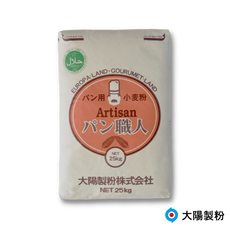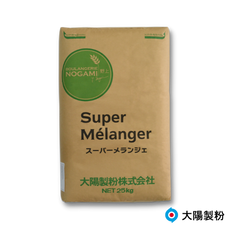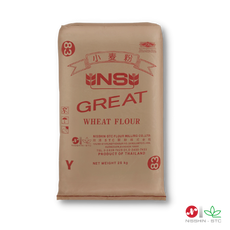The short answer would be: It depends on the quality, the protein and ASH %, and the application.
With so many types of flour in the market, you might find yourself standing at the supermarket aisle wondering which flour is right for your baking?
Wheat flour is the most common type of flour used in baking, which can be used for a wide variety of breads, cakes, pastries, and other baked goods.
However not all flour is created equal. The different types of wheat flour are classified based on their protein content and their intended use.
How to Classify Flour?
Each type of flour has its specific uses; some can be used in various applications whereas others are only suitable for certain applications. These applications are determined largely by the protein content of the flour.
Essentially, the protein content of flour is a key factor in determining its strength. The higher the protein content, the ‘stronger’ the flour. This is because the protein content of flour affects its ability to form gluten, which is a network of proteins that gives dough its elasticity and structure.

Generally, wheat flour found in supermarkets can range from 7% to 16% protein.
- Low protein flour has a protein content of 7-8% and is well-suited for making cakes, pastries, and other baked goods that require a light and delicate texture.
- Medium protein flour has a protein content of 10-12% and is a versatile flour that can be used for a variety of baked goods.
- High protein flour has a protein content of 12-14% and is well-suited for making bread, rolls, and other baked goods that require a chewy texture.
- Upper high protein flour has a protein content of 13-16% and is suitable for making domed loaf (i.e., higher volume bread) or bread with sub-ingredients such as dried fruits.
It’s essential to use the right flour with the right protein content for your specific application and to choose a brand which will provide you with the result that you want.
For example, as high protein flour makes for stronger gluten, it is most suited for breadmaking. However, it is important to note that the protein content and characteristic of each high protein flour can vary depending on the brand and the milling process which could affect the result – such as volume, colour, texture, or flavour.
High Protein Flour Experiment: How Different Brands Affect the Final Product
In this experiment, we will be using the same method, in the same environment to bake Japanese soft milk bread known as Nama Shokupan but with 3 different types of high protein flour, namely:
- Pan Syokunin by Taiyo Flour Milling
- Great by Nisshin-STC Flour Milling
- Local Brand Y
We will be exploring how the different characteristic of each flour affect the final product. Does quality and protein content really matter? Read on to find out.

In terms of quality, some flour companies bleach their flour with chemicals to further whiten the flour. Both Pan Syokunin and NS-Great flour contains no bleach and artificial preservatives. For comparison purposes, we are using local Brand Y which is also unbleached. We do however believe there are additives in Local Brand Y flour, which we will explain why later in the post.
The results for each brand of flour would differ in terms of volume and crumb texture. Why? This is because each bread flour has different quality, and all three brands contain different:
- Amount of Protein %
- Amount of ASH %
How does the Amount of Protein Affect Bread Dough?
Theoretically, the amount of protein affects the texture and volume of the bread.
- Texture: The protein content of flour is directly correlated with its ability to form gluten, which is a network of proteins that gives dough its elasticity and structure. Essentially, the higher the protein, the higher the gluten – this means the greater the flour’s gluten-forming potential in the dough, which then produces a bread loaf with good crumb structure.
- Volume: A higher protein content will result in a bread with a larger volume, as the gluten network will be able to trap more gas during baking.
However, it is important to note that the highest protein % does not equal ‘The Best Option’ as each flour yields different texture and aroma. Furthermore, the final bread volume may differ because the quality of protein and power of gluten differs for each flour brand.
Generally, lower protein dough is easier to knead and shape, but it will not have as much structure or volume as dough with a higher protein content. Higher protein dough may be more challenging to work with, but it produces a chewy, sturdier bread with a higher volume.

All 3 brands have varying protein content % ranging between 12.2-13.5%:
- Pan Syokunin by Taiyo Flour Milling has the lowest protein content at 12.2%
- Great by Nisshin-STC Flour Milling has between 12.2-13%
- Local Brand Y has the highest protein content at 13-13.5%
We will explore how the protein content affects the dough and final product.
Does the Amount of ASH Content Matter?
Ash content refers to the amount of ash that would be left over if you were to burn a small sample of flour. The ash content in high protein flour is an important factor as it can affect the taste, colour, and texture of the bread. The ash content shows the amount of mineral or inorganic content in the flour – which fundamentally is another measurement of quality.

- Higher ash content = flour contains more of the germ, bran, and outer endosperm
- Lower ash content = flour is more of the endosperm part and is more highly refined (i.e., lower extraction rate)
Here is a table that summarizes the differences between low or high ash content:

In general, higher protein flours have a higher ash content than lower protein flours. This is because the bran and germ of the wheat kernel, which are high in minerals, are removed during the milling process to produce low protein flour.
This is also demonstrated in the three flour options that we are using in this experiment:
- Pan Syokunin by Taiyo Flour Milling with lowest protein content has the lowest ash content of 0.39%
- Followed by Great by Nisshin-STC Flour Milling with ash content of 0.4%
- Lastly Local Brand Y with the highest protein content has the highest ash content of 0.5-0.55%

Three Brands of High Protein Flours: Will there be a Difference?
For this experiment, we will be using all three brands of high protein flour with varying protein and ash content to bake a loaf of Japanese milk bread. Let’s check out the progress from kneading, to after baking to see which brand will rise to the top (pun intended).

It was easier to achieve windowpane for Pan Syokunin and NS-Great dough where both the dough stretched smoothly. Pan Syokunin’s dough was softer with finer texture, whereas NS-Great’s dough was soft but firmer in texture. Brand Y’s dough on the other hand formed faster, but it was tough, firm and not as elastic.

As you can see above, Pan Syokunin has the softest and most tender dough of the three. It is the least firm, and it looks flatter than the other two flours. Pan Syokunin dough was also the easiest to manage amongst the three.
NS-Great has a soft and elastic dough that is firmer than Pan Syokunin's dough. Similar to Brand Y, NS-Great is able to hold its shape better than Pan Syokunin’s dough.
Brand Y has a firm but not as elastic dough, making it the toughest dough to manage. It has a coarser, rougher texture than the other two flours. The dough was very puffy with lots of air bubbles and dry patches throughout.
Generally, there were minimal differences in the dough during proofing across all three brands. The differences became more pronounced after baking.

Pan Syokunin’s loaf was soft and had an even, golden brown crust. It was also very fragrant. This loaf was the softest of the three. NS-Great’s loaf was firmer than the other two loaves. It also had a slightly darker crust.
On the other hand, Brand Y’s loaf had an uneven color, rough texture, and a lot of tears and bubbles. It was the least appealing of the three loaves.
High quality protein of gluten has strong power to hold the gluten expansion, but lower quality protein (which usually contains leavening additives) has lesser to no power to hold the expansion. Despite Brand Y having the highest protein %, we believe the addition of additives resulted in the dough over-expanding, resulting in tears.
The addition of leavening additives may also cause the dough to be puffier with lots of air bubbles, which results in uneven breadcrumbs with big holes evident in the crumb texture comparison below.

Pan Syokunin produced a loaf with very soft and silky texture. The interior white crumb was light and airy, almost cotton-like. It feels like the bread just melts in your mouth. With a very thin skin, it felt as if the loaf was crustless.
NS-Great’s loaf was also soft and fluffy, but firmer than Pan Syokunin. The crust is like a thin crispy skin, with a moist and slightly chewy bite.
Brand Y also produced a soft loaf, but with big holes that runs through the bread. The bottom of the loaf is also slightly gummy. During the shaping process, we found that there were a lot of air bubbles and dry patches on the dough which we believe resulted in the tears and holes of various sizes throughout the bread.
Three High Protein Flours, Three Different Results
This experiment illustrates the contrast between the three high protein flour with varying protein and ASH content:

- TEXTURE: Pan Syokunin produced a loaf that was pillowy soft with the fluffiest texture, and very even crumbs. NS-Great produced a bread that is firmer with a thicker skin crust, and chewier texture. Brand Y on the other hand was soft with uneven crumbs, big holes and chewy texture.
- VOLUME: With lower protein content, it is evident that its gluten structure is not as strong as NS-Great and Brand Y. NS-Great demonstrated better performance in terms of volume making it a great selection of flour for high volume loaves.
- COLOUR: As can be seen in the above photo, Pan Syokunin’s crumbs are brighter and the whitest amongst the three. NS-Great loaf leans slightly more towards ivory white whereas Brand Y is a lot duller in colour whereby the crumbs looks yellower and darker. This demonstrates that the higher the ASH content % is, the darker the colour of the crumbs.
Based on the final results, it is evident that high protein flour with the highest protein content such as local Brand Y may not necessarily be ‘the best option’. The quality of the flour one uses does make a huge difference in the texture and final product.

Pan Syokunin and NS-Great are both high-quality high protein flours that are suitable for a variety of baking applications. When choosing high protein flour for bread making, it is important to consider the desired texture, and volume of the bread.
Choosing the Right Flour for Your Recipe
To sum up, if you are looking for a chewy, sturdier bread then you will want to choose a higher protein flour such as NS-Great.
If you are looking to produce a soft, fluffy bread with silky crumb texture, then you will want to choose flour with a slightly lower protein content such as Pan Syokunin.
The main difference between lower protein content (Pan Syokunin) and higher protein content (NS-Great/Brand Y) in high protein flour is the amount of gluten that is formed. Gluten is what gives bread its structure and elasticity. The higher the protein content of the flour, the more gluten will be formed, resulting in a stronger and chewier bread such as NS-Great and Brand Y.
Pan Syokunin with a slightly lower protein content is most suitable for those wanting to achieve the soft, silky texture making it perfect for sweet buns. To achieve a bigger volume for loaves, adding a small percentage of Taiyo Super Melanger flour, which is an upper high protein flour would help.

In the above comparison photo, you may notice the difference in volume for the loaf made using Pan Syokunin alone, and how the combination of Pan Syokunin + Super Melanger helps achieve a higher volume loaf with better gluten structure yet still maintaining its soft and silky texture.
Therefore, your selection of high protein flour should reflect the type of texture, volume, and aroma you wish to achieve for your final product.
Contact us HERE if you wish to learn more about Pan Syokunin, Super Melanger or NS-Great high protein flour. Here at Marubishi, we are dedicated to helping you find the product that best suits your needs.
Try this Nama Shokupan Recipe
Nama Shokupan is Japanese version of milk bread that is soft, fluffy and widely enjoyed in Japan daily. Its subtly sweet, and milky taste, paired with its cloud-like pillowy soft texture makes it perfect to enjoy as breakfast toast or used as sandwich bread.
This recipe below uses the sponge dough method and yields an incredibly soft, moist and fluffy shokupan bread! Give it a try. ;)





1件のコメント
Thank you for your article. I was trying to understand the different flour available in Malaysia for bread. I make my own sourdough bread using Bob’s Red Mills flour. However I also use Pan Shokunin flour mix with wholewheat flour. I would like to try making the milk bread but using sourdough. Do you have suggestion how to go about this.